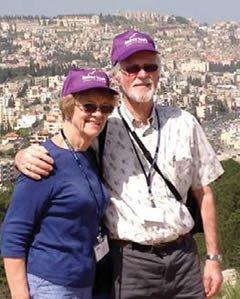A Pilgrimage to the Holy Land

We’re back from the land where God appeared and spoke to men.
We were in the country of Abraham and Samuel and Isaiah and Jeremiah.
We were in the place where God became Man.
And we stood near the place where that God-Man was nailed to the cross, died, was buried and arose.
We’re back, but we’re not the same.
We’re not the same, for we were at Ibillin where we witnessed the power of a faith vision, where Father Chacour, now Archbishop of Galilee, built from nothing a set of first-rate educational institutions that hold hope for the 3,000 Palestinian children and adults who attend.
We’re not the same, for we heard him tell us that surely Israel needs our friendship and should continue to receive it, but also to remember that Palestinians are paying the bill for what others have done against his beloved Jewish brothers and sisters in the Holocaust and Auschwitz and other death camps. We were painfully reminded of those words when we heard the stories of our Palestinian Christian tour guide and saw the disturbing contrasts within the West Bank and the obscene wall in Bethlehem. With Christ we weep over Jerusalem and this divided people.
We’re not the same, for we were at the Al Basma Center in Bethlehem and danced with a smiling group of disabled Palestinian youth and adults whose lives are being transformed through vocational training, where they grow pride in the products they learn to make and skills they master.
The center receives no support from the state of Israel, and we were deeply moved by the loving spirit that gives rise to this place within a community of meager means.
We’re not the same, for we walked the rocky ground where the “father of all believers” walked, where Saul lived and died in battle, where David hid in caves, where Hezekiah built his tunnel, where Herod designed and planted his many opulent palaces and where he was buried in a magnificent tomb that had been years in the making, now as reduced to ruin as was his worm-eaten body.
We’re not the same, for the baby Herod thought he had killed grew into the Messiah. We stood in the rushing waters of the Jordan, remembering his baptism, held hands, prayed and sang “When Peace Like a River.” On a high, rocky hill that looked down on the Sea of Galilee, we sat in the grass around Pastor Bill, who recited from memory Jesus’ most memorable sermon. The power of our Savior’s words in Matthew 5 moved us deeply; we will never read that chapter in the same way again.
We’re not the same, for we walked the Son of Man’s final journey, the journey of Holy Week. Each of us found a quiet place in the Garden of Gethsemane for meditation and prayer. Then we descended into the noisy, narrow streets of Jerusalem and followed the Via Dolorosa along the Stations of the Cross and remembered that the Lord of lords stumbled here under the weight of a sin-laden cross on which he would be crucified as the most despised of criminals. And when at last we approached the Place of the Skull, we remembered the words we had sung in the Jordan: “My sin—oh, the bliss of this glorious thought!—my sin, not in part, but the whole, is nailed to the cross, and I bear it no more, praise the Lord, praise the Lord, O my soul.”
Then, our pilgrimage ending in the Garden Tomb, we commemorated in Holy Communion the Savior’s body broken and blood shed for our eternal healing. Each of us took a small stone from the “altar” as a permanent reminder of this holy moment, the words of the hymn welling up in our soul:
“What language shall I borrow to thank you dearest Friend,
for this your dying sorrow, your mercy without end?
Lord, make me yours forever, a loyal servant true,
and let me never, never outlive my love for you.”
—Henry Baron, professor of English emeritus






